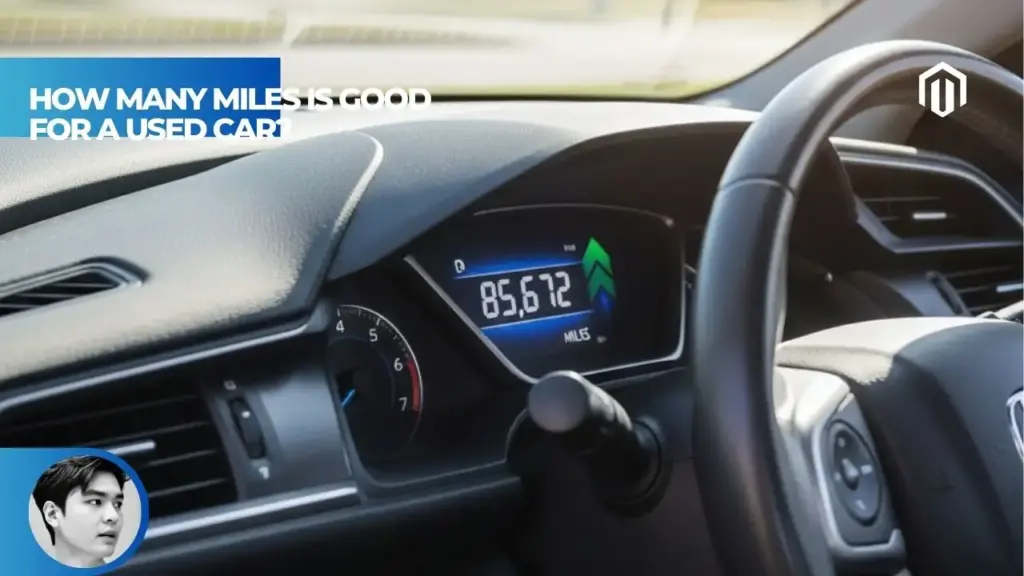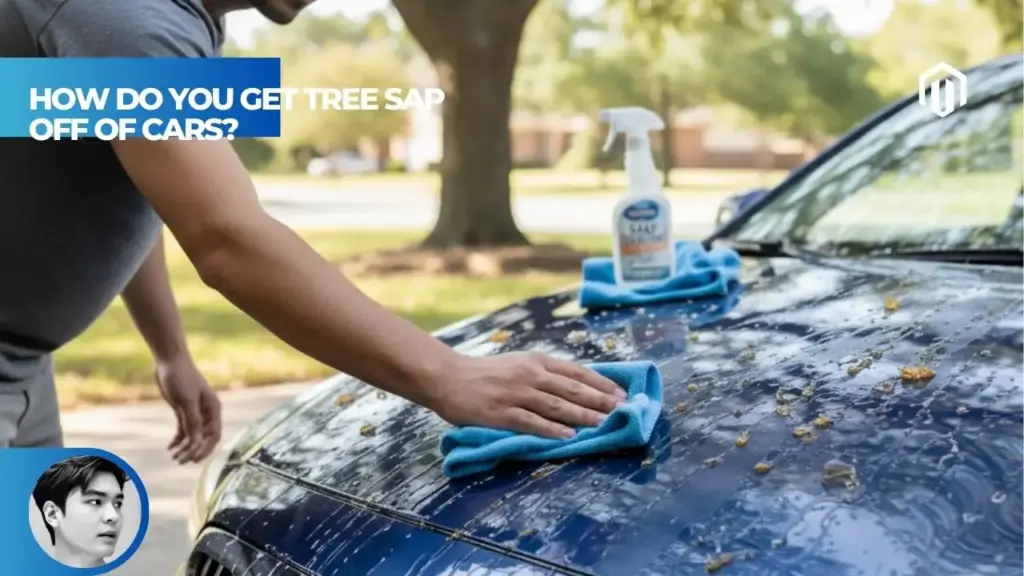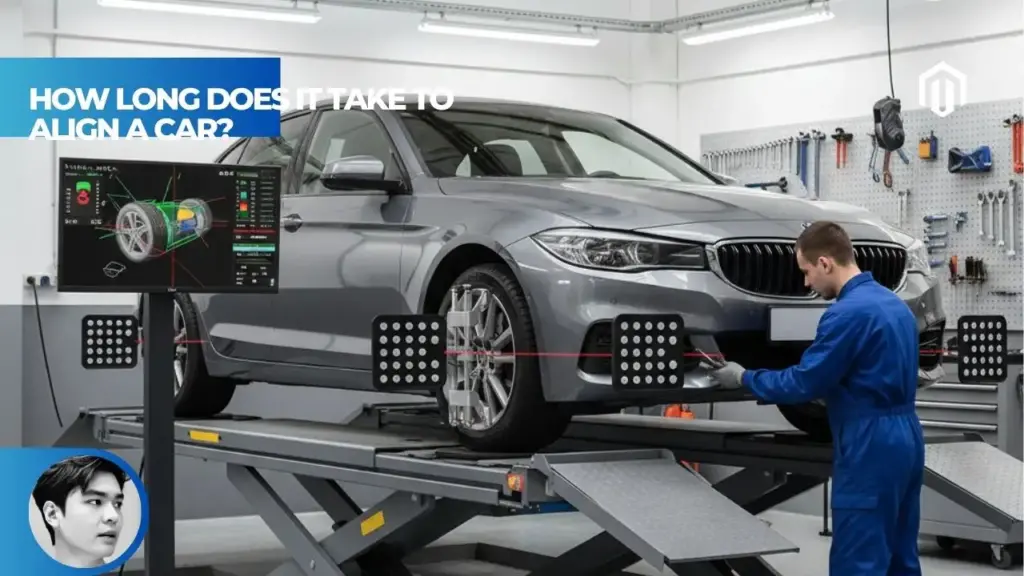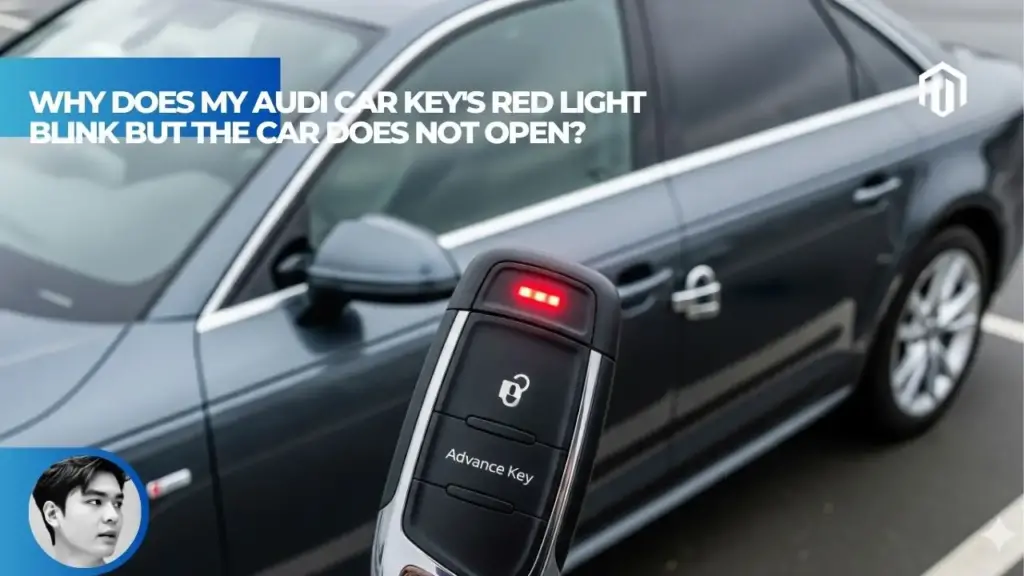You may also like:
- 【Explained】How Many Miles Can Audi Last? Factors Affecting Lifespan and Reliability
- 【Explained】What Mileage Do BMW Start to Break Down? High-Mileage Costs and Lifespan
- 【Explained】What’s the Maintenance Cost for BMW? 10-Year Ownership Averages and Budgeting
- 【Explained】If Airbags Deploy, Is the Car Totaled? (The 2025 Cost vs. Value Guide)
- 【Explained】What Is More Reliable: BMW or Mercedes? (Repair Costs)
Good mileage for a used car is typically 10,000-15,000 miles per year of the vehicle’s age, meaning a 5-year-old car with 50,000-75,000 miles would be considered average. However, a well-maintained car with 100,000 miles often represents a better purchase than a neglected vehicle with 40,000 miles, as modern cars can reliably last 200,000-300,000 miles with proper care.

What Is Considered Good Mileage for a Used Car?
Understanding what constitutes acceptable mileage begins with recognizing industry benchmarks while acknowledging that these numbers serve merely as starting points. The automotive landscape has evolved significantly, with modern engineering pushing vehicle longevity far beyond previous generations’ expectations.
Average Miles Per Year for a Car (10,000 to 15,000 Miles)
The average American driver covers approximately 12,200 miles annually according to the Federal Highway Administration’s 2025 data[1]. This figure represents a slight recovery from pandemic lows but remains below the pre-2020 peak of nearly 14,500 miles per year. Understanding this baseline helps evaluate whether a used car has seen typical usage patterns.
Regional variations significantly impact these averages. Drivers in Wyoming average 21,588 miles annually, while Washington D.C. residents drive only 6,695 miles per year[2]. When evaluating a used car’s history, consider where it spent most of its life, as this context affects wear patterns beyond simple mileage numbers.
Good Mileage for a 3-Year-Old Car
A 3-year-old vehicle with 30,000-45,000 miles falls within the ideal range for used car buyers. This mileage suggests regular but not excessive use, likely maintaining warranty coverage while avoiding the steepest depreciation curve[3]. Vehicles in this range often represent the sweet spot for value-conscious buyers.
Cars at this age with significantly lower mileage might seem appealing, but require careful inspection. A 3-year-old car with only 10,000 miles may have spent extended periods sitting idle, potentially developing issues unrelated to mileage. Consider how long does it take to buy a car when planning your purchase timeline to allow proper inspection.
Good Mileage for a 5-Year-Old Car
The benchmark for a 5-year-old car ranges from 50,000-75,000 miles, representing average usage patterns. At this age, most vehicles have completed their initial depreciation phase while retaining substantial mechanical life[3]. According to Autvex analysis, cars in this category offer optimal value propositions for budget-conscious buyers.
Vehicles exceeding 75,000 miles at five years old aren’t automatically problematic. Highway-driven cars accumulate miles quickly with minimal wear, making a 90,000-mile highway commuter potentially more reliable than a 40,000-mile city car.
Good Mileage for a 10-Year-Old Car
A decade-old vehicle with 100,000-150,000 miles represents typical usage and potentially excellent value. Modern vehicles routinely exceed 200,000 miles when properly maintained, making these higher-mileage options increasingly viable[4]. The key lies in documentation proving consistent maintenance throughout the vehicle’s life.
Ten-year-old cars with unusually low mileage (under 60,000) warrant extra scrutiny. Extended storage periods can cause rubber seals to deteriorate, fluids to degrade, and batteries to fail prematurely. Understanding what happens when your car is totaled but still drivable helps evaluate insurance implications for older vehicles.
Understanding Low vs High Mileage
The traditional binary classification of “low” versus “high” mileage oversimplifies the complex reality of vehicle condition assessment. Modern buyers need nuanced understanding of how different mileage levels impact vehicle reliability and value.
What Is Considered Low Mileage for a Used Car
Low mileage typically means under 10,000 miles per year of the vehicle’s age. A 5-year-old car with 35,000 miles qualifies as low mileage, potentially commanding premium prices[2]. However, low mileage doesn’t automatically guarantee superior condition or reliability.
Extremely low mileage can indicate:
- Limited use by elderly owners
- Secondary vehicle status
- Extended storage periods
- Incomplete break-in processes
- Potential odometer tampering (rare but possible)
What Is Considered High Mileage for a Used Car
High mileage generally refers to vehicles exceeding 15,000 miles annually. A 5-year-old car with 90,000 miles falls into this category but shouldn’t be dismissed automatically[1]. Highway-driven vehicles often accumulate high mileage with minimal mechanical stress.
High-mileage vehicles frequently offer:
- Significant cost savings (20-40% below average)
- Proven reliability (survived this long)
- Complete maintenance histories
- Lower insurance costs
- Minimal additional depreciation
Problems with Low Mileage Old Cars (Dry Rotted Seals)
Vehicles sitting idle for extended periods develop unique problems regardless of low odometer readings. Rubber components including seals, hoses, and belts deteriorate through age rather than use. Dry rot affects these components after 5-7 years regardless of mileage[5].
Common issues in low-mileage older cars include:
- Degraded coolant hoses requiring replacement
- Hardened brake lines prone to failure
- Seized brake calipers from inactivity
- Contaminated fluids needing immediate replacement
- Dead batteries and corroded terminals
- Flat-spotted tires from prolonged parking
Is Low Mileage Always Good?
Low mileage represents just one factor in the complex equation of used car evaluation. A vehicle driven regularly maintains better overall health than one sitting unused for months. Mechanical components need regular operation to maintain proper lubrication and prevent corrosion.
Consider the 2025 BMW 2-Series as an example: a well-maintained higher-mileage model often proves more reliable than a garage queen with minimal use. Regular operation keeps seals pliable, prevents moisture accumulation, and ensures all systems function properly.
Why Maintenance Matters More Than Mileage
The paradigm shift from mileage obsession to maintenance focus reflects modern automotive reality. Today’s vehicles, when properly maintained, routinely exceed mileage thresholds that would have been unthinkable decades ago.
Mileage vs Maintenance History
Maintenance history provides the true window into a vehicle’s future reliability potential. A car with 150,000 documented miles of regular service often outlasts a 60,000-mile vehicle with spotty maintenance records[4]. Oil changes every 5,000-7,500 miles, transmission services, and timely belt replacements prevent catastrophic failures.
Critical maintenance milestones include:
- Oil changes: Every 5,000-10,000 miles (varies by oil type)
- Transmission fluid: 30,000-60,000 miles
- Coolant flush: 50,000-100,000 miles
- Brake fluid: Every 2-3 years
- Spark plugs: 30,000-100,000 miles (varies by type)
Is a High-Mileage Car with Good Maintenance Better?
Statistical evidence increasingly supports choosing well-maintained high-mileage vehicles over neglected low-mileage alternatives. According to iSeeCars data, properly maintained vehicles have an 8.6% chance of reaching 250,000 miles, with certain models like the Toyota Tundra achieving 36.6% probability[4].
High-mileage vehicles with complete service records demonstrate:
- Proven reliability (survived this long)
- Known issue resolution
- Established maintenance patterns
- Lower cost per remaining mile
- Predictable future expenses
How to Check Vehicle Maintenance History
Verifying maintenance history requires systematic investigation beyond dealer promises. Start with vehicle history reports from Carfax or AutoCheck, which capture service records from participating shops. However, these reports miss independent shop work and DIY maintenance.
Request comprehensive documentation including:
- Original owner’s manual with service stamps
- Receipts for all maintenance and repairs
- Oil change stickers showing consistency
- Tire purchase records indicating regular replacement
- Registration history confirming continuous use
According to Autvex experts, vehicles with complete maintenance documentation command 15-20% premiums over those without records.
How Important Is a Maintenance History Report?
Maintenance documentation ranks as the single most important factor when evaluating used vehicles, surpassing mileage, age, or cosmetic condition. Complete records reduce purchase risk by revealing the vehicle’s true mechanical health and predicting future reliability[5].
Comprehensive maintenance history provides:
- Verification of manufacturer’s schedule compliance
- Evidence of preventive maintenance
- Documentation of resolved issues
- Proof of quality parts usage
- Indication of owner care level
Missing maintenance records should trigger additional scrutiny through professional pre-purchase inspections. Consider how long does it take to align a car as regular alignments indicate conscientious ownership.

Highway Miles vs City Miles
The type of driving dramatically impacts vehicle wear patterns, making mileage context as important as the numbers themselves. Understanding these differences helps evaluate whether higher mileage represents acceptable risk.
Does It Matter if a Car Has Highway Miles or City Miles?
The distinction between highway and city miles significantly impacts vehicle longevity and condition. Highway miles typically cause 40-60% less wear on critical components compared to city driving[3]. This difference stems from consistent operating temperatures, minimal brake usage, and steady-state engine operation.
City driving creates harsher conditions through:
- Frequent cold starts causing increased wear
- Constant acceleration and deceleration cycles
- Excessive brake and transmission usage
- Extended idling periods
- Stop-and-go stress on cooling systems
Why Highway Miles Are Less Taxing on Vehicles
Highway driving maintains optimal operating conditions for extended periods. Engines reach and maintain ideal temperatures, oil circulates properly, and transmissions remain in higher gears. The EPA estimates highway driving improves fuel economy by 20-30% compared to city driving, reflecting reduced mechanical stress[1].
Components benefiting from highway miles:
- Engine: Consistent temperature, optimal lubrication
- Transmission: Minimal shifting, reduced clutch wear
- Brakes: Limited use, extended pad/rotor life
- Suspension: Smooth road surfaces, reduced impact
- Air conditioning: Steady-state operation
Impact of Driving Style on Vehicle Wear
Individual driving habits create more variation in vehicle wear than simple mileage accumulation. Aggressive driving can double wear rates compared to conservative operation. Hard acceleration, late braking, and high-speed cornering stress components beyond design parameters.
Indicators of gentle driving history:
- Even tire wear patterns
- Original brake components lasting longer
- Clean engine oil between changes
- Smooth transmission operation
- Intact interior components
Research specific models like Audi Q5 years to avoid to understand model-specific wear patterns and common issues.
Breaking the 100,000 Mile Myth
The arbitrary 100,000-mile threshold that once defined automotive end-of-life has become increasingly irrelevant with modern engineering advances.
Is 100,000 Miles Too Many for a Used Car?
Modern vehicles routinely exceed 100,000 miles with minimal issues, making this traditional barrier obsolete. Industry data shows the average vehicle age now exceeds 12 years with corresponding mileage well above 100,000[3]. The psychological barrier persists despite technological improvements.
Factors enabling extended vehicle life:
- Improved metallurgy and materials
- Better lubricants and longer intervals
- Electronic engine management
- Tighter manufacturing tolerances
- Corrosion-resistant materials
How Many Miles Can a Car Last? (200,000-300,000 Miles)
Contemporary vehicles demonstrate remarkable longevity when properly maintained. Consumer Reports indicates properly serviced vehicles from reliable manufacturers can achieve 200,000+ miles[6]. Some models significantly exceed these benchmarks, with Toyota and Honda products routinely surpassing 300,000 miles.
Top models for longevity (iSeeCars 2024 study):
- Toyota Tundra: 36.6% reach 250,000 miles
- Toyota Sequoia: 26.1% reach 250,000 miles
- Toyota 4Runner: 25.8% reach 250,000 miles
- Toyota Highlander Hybrid: 25.2% reach 250,000 miles
- Honda Ridgeline: 24.9% reach 250,000 miles
Buying a Used Car with 150,000 Miles
Vehicles with 150,000 miles represent viable options when properly evaluated. At this mileage, most depreciation has occurred, making these vehicles excellent value propositions. Insurance costs decrease, registration fees drop, and further depreciation slows significantly[4].
Essential considerations for high-mileage purchases:
- Complete pre-purchase inspection ($150-$300)
- Verification of major service completion
- Budget for immediate maintenance needs
- Research model-specific issues
- Confirm parts availability
Understanding how many miles can Audi last helps set realistic expectations for premium brands.
What Happens After 200,000 Miles
Crossing 200,000 miles doesn’t signal imminent failure for well-maintained vehicles. Many components are designed for this lifespan, though certain items require attention. Preventive replacement of aging components maintains reliability beyond this milestone.
Common 200,000-mile maintenance items:
- Suspension overhaul: $1,500-$3,000
- Transmission service or rebuild: $2,000-$4,000
- Cooling system overhaul: $500-$1,500
- Exhaust system replacement: $500-$2,000
- Air conditioning service: $500-$1,500
Age vs Mileage Considerations
The age versus mileage debate requires nuanced understanding of how each factor impacts vehicle condition and value.
Is Age or Mileage More Important When Buying a Used Car?
Neither age nor mileage alone determines vehicle condition; the interaction between these factors matters most. A 5-year-old car with 100,000 highway miles often proves superior to a 10-year-old car with 50,000 city miles[2]. Maintenance history ultimately trumps both factors.
Age primarily affects:
- Rubber component degradation
- Fluid contamination
- Corrosion development
- Technology obsolescence
- Safety feature availability
Mileage primarily impacts:
- Mechanical wear
- Maintenance requirements
- Remaining service life
- Warranty coverage
- Resale value
Would You Rather Buy a New Car with High Miles or an Old Car with Low Miles?
Given the choice, newer high-mileage vehicles generally represent better purchases than older low-mileage alternatives. Modern vehicles benefit from improved materials and engineering, making a 3-year-old car with 75,000 miles preferable to a 10-year-old car with 30,000 miles.
Newer vehicles advantages:
- Current safety technology
- Modern fuel efficiency
- Updated infotainment systems
- Better crash protection
- Remaining warranty potential
Consider the 2024 BMW 2-Series Gran Coupe for modern engineering benefits.
What Is the Sweet Spot for Mileage on a Used Car?
The optimal mileage range for used car purchases falls between 30,000-60,000 miles for vehicles 3-5 years old. This range balances depreciation savings against remaining service life, providing maximum value[5]. Vehicles in this range have typically completed initial break-in while avoiding major service requirements.
Sweet spot characteristics:
- 40-50% depreciation already absorbed
- Factory warranty potentially transferable
- Major services not yet required
- Modern safety and technology features
- Proven reliability record established
Mileage Guidelines by Vehicle Type and Budget
Different vehicle categories exhibit varying durability characteristics, affecting acceptable mileage thresholds.
Good Mileage for a Used Truck
Trucks typically demonstrate superior longevity compared to passenger cars, with 150,000 miles representing mid-life rather than end-of-life. Full-size trucks from Toyota, Ford, and Chevrolet routinely exceed 200,000 miles in commercial service[4].
Truck mileage considerations:
- Diesel engines often last 300,000+ miles
- Commercial use indicates regular maintenance
- Towing history impacts transmission wear
- Four-wheel drive systems require additional service
- Bed condition indicates usage type
Good Mileage for a Used Toyota
Toyota’s reputation for reliability makes higher mileage more acceptable. A Toyota with 100,000 miles often represents early middle age rather than advanced wear. Multiple Toyota models dominate longevity studies, with seven of the top 10 longest-lasting vehicles[4].
Toyota/Lexus models excelling at high mileage:
- Land Cruiser: Legendary durability
- 4Runner: Proven off-road longevity
- Camry: Efficient highway cruiser
- Highlander: Family-friendly reliability
- Lexus GX: Luxury meets durability
Best Mileage for a Used Car Under $10,000
Budget constraints often necessitate accepting higher mileage vehicles. Under $10,000, expect vehicles with 80,000-120,000 miles depending on make, model, and age. Focus on maintenance history and pre-purchase inspection results rather than mileage alone.
Budget buying strategies:
- Prioritize Japanese brands for reliability
- Accept cosmetic imperfections
- Budget for immediate maintenance
- Research model-specific issues
- Consider certified pre-owned when available
Used Car Under 50,000 Miles
Vehicles under 50,000 miles command premium prices but offer extended service life and potential warranty coverage. These low-mileage examples suit buyers prioritizing longevity over initial savings[3].
Benefits of sub-50,000 mile vehicles:
- Factory warranty potentially active
- Major services not yet required
- Modern safety features included
- Financing readily available
- Higher resale value retention
Autvex research indicates vehicles under 50,000 miles retain 20-30% more value than those exceeding 75,000 miles.

Key Takeaways
- Average good mileage equals 10,000-15,000 miles per year of vehicle age
- Maintenance history matters more than odometer readings
- Modern cars routinely last 200,000-300,000 miles with proper care
- Highway miles cause 40-60% less wear than city driving
- The 100,000-mile barrier is an outdated myth
- Sweet spot for value: 3-5 years old with 30,000-60,000 miles
- Always obtain pre-purchase inspection regardless of mileage
Decision Path / Next Steps
After understanding mileage implications, follow this strategic approach to used car purchasing:
- For First-Time Buyers: Target 3-5 year old vehicles with 40,000-70,000 miles and complete service records. Budget an additional 10% for immediate maintenance needs. Research how long does it take to buy a car to plan your purchase timeline effectively.
- For Budget-Conscious Shoppers: Consider well-maintained vehicles with 80,000-120,000 miles from reliable brands like Toyota or Honda. The substantial savings offset higher mileage risks when maintenance history is documented. Explore Audi A4 years to avoid if considering premium brands.
- For Long-Term Owners: Prioritize maintenance records over mileage numbers. A 100,000-mile vehicle with complete documentation often outlasts a 50,000-mile car with unknown history. Consider certified pre-owned for warranty protection.
- For Maximum Value: Focus on the 30,000-60,000 mile range in 3-5 year old vehicles. This sweet spot balances depreciation savings with remaining service life. Always invest in professional pre-purchase inspection regardless of seller claims.
FAQs
What is considered good mileage for a used car?
Good mileage is typically 10,000-15,000 miles per year of the car’s age. A 5-year-old car with 60,000-75,000 miles would be considered average.
Is 100,000 miles too many for a used car?
No, modern cars can easily last 200,000-300,000 miles with proper maintenance. The 100,000-mile threshold is an outdated myth.
Is age or mileage more important when buying a used car?
Maintenance history matters most. Age and mileage are both factors, but a well-maintained older car often beats a newer neglected one.
What is the “sweet spot” for mileage on a used car?
The sweet spot is typically 3-5 years old with 30,000-60,000 miles, balancing depreciation savings with remaining reliability.
How many miles is too many for a used car?
There’s no fixed number. Focus on maintenance records rather than mileage alone. Well-maintained cars can exceed 200,000 miles reliably.
What is the average number of miles driven per year?
The average is 12,200 miles per year according to 2025 FHWA data, though this varies significantly by state and individual driving patterns.
Is a 10-year-old car with 50,000 miles a good buy?
Yes, if properly maintained. This represents only 5,000 miles/year, but verify it wasn’t sitting idle causing seal deterioration.
Would you rather buy a new car with high miles or an old car with low miles?
A newer high-mileage car with maintenance records typically offers better reliability than an old low-mileage car with unknown history.
Does it matter if a car has “highway miles” or “city miles”?
Yes, highway miles cause 40-60% less wear on brakes, transmission, and engine than stop-and-go city driving.
How many miles can a car last?
Modern cars can last 200,000-300,000 miles with proper maintenance. Some brands like Toyota and Honda routinely exceed these figures.
What is considered high mileage for a 5-year-old car?
More than 75,000 miles (15,000/year) would be considered high for a 5-year-old car, though not necessarily problematic if maintained.
How important is a maintenance history report?
Extremely important. Maintenance records provide the best indicator of a car’s true condition and future reliability, more than mileage alone.
References
- Kelley Blue Book. (2025). Average Miles Driven Per Year: Why It Is Important. https://www.kbb.com/car-advice/average-miles-driven-per-year/
- ConsumerAffairs. (2024). How many miles does the average person drive a year? 2025. https://www.consumeraffairs.com/automotive/how-many-miles-does-the-average-person-drive-a-year.html
- Car and Driver. (2020). How Many Miles Does a Car Last? https://www.caranddriver.com/research/a32758625/how-many-miles-does-a-car-last/
- Forbes. (2024). Longest Lasting Cars: Vehicles Likely To Hit 250,000 Miles. https://www.forbes.com/sites/kbrauer/2024/08/13/longest-lasting-cars-cars-likely-to-hit-250000-miles-per-new-study/
- PWUC. (2025). How Many Miles Are Too Many? A 2025 Perspective on Used Car Mileage. https://www.pwuc.com/how-many-miles-are-too-many-a-2025-perspective-on-used-car-mileage/
- Consumer Reports. (2023). What Is a Reasonable Life Span for a Modern Car? https://www.consumerreports.org/cars/car-reliability-owner-satisfaction/what-is-a-reasonable-life-span-for-a-modern-car-a4678774857/

I am a senior automotive analyst at Autvex. Expert vehicle evaluations, in-depth reviews, and objective analysis helping readers make informed automotive decisions with years of industry experience.









